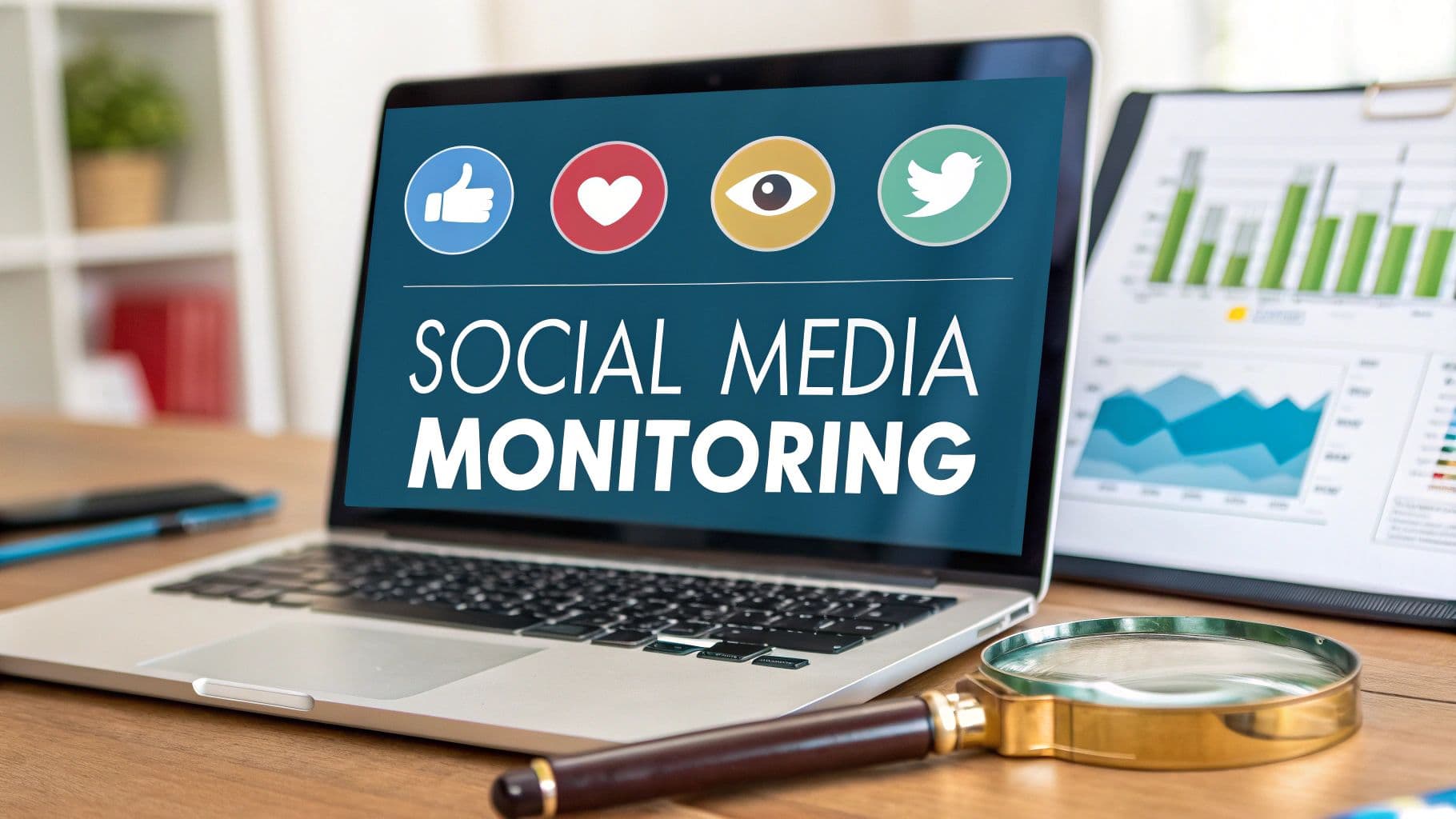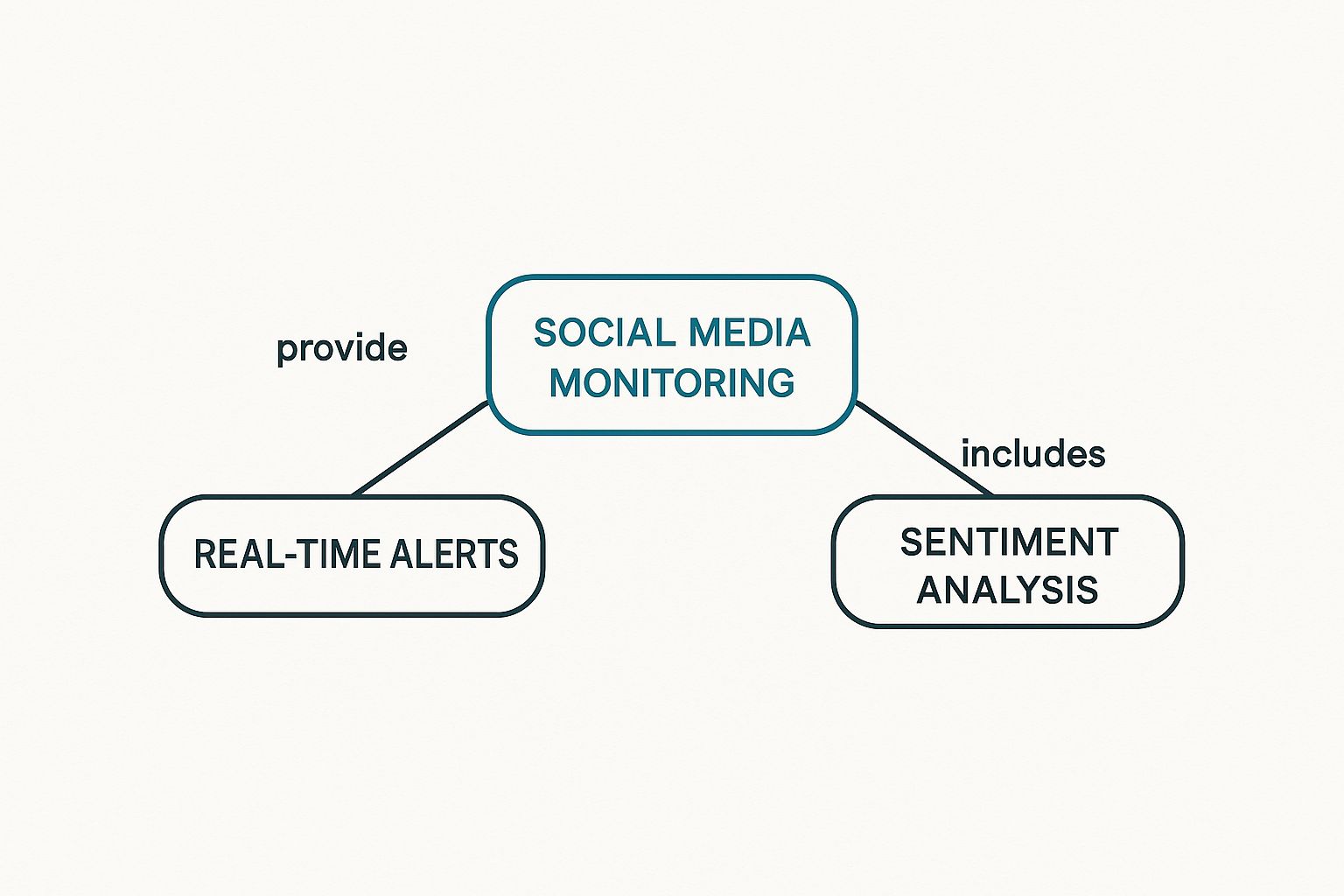
Think of social media monitoring as your brand’s eyes and ears online. It’s the ongoing process of spotting and responding to individual mentions of your brand, your products, your competitors, and any keywords relevant to your business across the internet.
This isn’t just about social platforms; it covers everything from news sites and blogs to forums and review sites. It's your real-time feedback loop.
What Does Social Media Monitoring Actually Involve?
Let's ditch the textbook definitions. Social media monitoring is like having a digital command center for your brand's reputation. It’s the difference between guessing what people are saying and knowing exactly who is saying what, where they're saying it, and why it matters—right now.
This is a proactive, intelligence-gathering mission. For example, at BillyBuzz, we do more than just track our own name. We keep a close watch on specific communities, like the r/startups subreddit, looking for conversations about problems our tool can solve. We also set up alerts for our competitors' names mentioned alongside words like "glitchy" or "poor support." This turns a simple task into a strategic advantage, letting us find warm leads and get honest feedback before anyone else.
The goal is to move from defense to offense. You’re not just waiting to handle a complaint; you’re actively seeking out opportunities.

As you can see, the process isn't just about collecting data. It's about turning that stream of information into insights you can act on immediately.
Monitoring vs Listening: A Quick Breakdown
People often use "monitoring" and "listening" interchangeably, but they are two sides of the same coin. Monitoring is the micro-level, day-to-day work, while listening is the macro-level, big-picture strategy.
Here’s a simple table to break it down:
| Aspect | Social Media Monitoring (The 'What') | Social Media Listening (The 'Why') |
|---|---|---|
| Focus | Individual mentions, comments, and messages. | Overall trends, sentiment, and patterns. |
| Timeframe | Real-time, immediate. | Long-term, strategic. |
| Goal | React and respond quickly. | Analyze and adapt strategy. |
| Nature | Reactive and tactical. | Proactive and strategic. |
| Example | Responding to a customer complaint on Twitter. | Analyzing conversation trends to inform a new product feature. |
Think of it this way: monitoring is like firefighters responding to a specific fire, while listening is like city planners analyzing data to prevent future fires. You really need both to succeed.
The Foundation of Smart Decisions
Good monitoring isn't just about piling up mentions. The real value comes from turning that raw data into clear insights that shape your business strategy. To do that, you have to master social media marketing metrics to understand what’s actually working. Without solid metrics, you're just collecting noise.
The business world is taking notice. The global market for media monitoring tools hit an estimated USD 5.1 billion in 2024. That number is set to climb as more companies realize they need this real-time intelligence to stay competitive and react to shifts in public opinion.
As a founder, you can't afford to be in the dark. Monitoring gives you the data to protect your reputation, understand customer needs, and spot opportunities your competitors are missing. It’s about making smarter, faster decisions.
So, what is social media monitoring at its core? It’s your unfiltered connection to what your market truly thinks and feels. It gives you the raw material you need to build a better product, create marketing that connects, and find customers who are already looking for you.
Why Monitoring Is Your Startup’s Secret Weapon

As a founder, your time is your most valuable asset. You can't afford to chase vanity metrics or get lost in abstract theories. You need strategies that directly fuel growth, and that's exactly where social media monitoring comes in.
Think of it as your own personal intelligence agency. It’s a direct line to the raw, unfiltered conversations your customers, competitors, and potential leads are having right now. This isn't just about passively counting brand mentions; it's about actively listening to the market. At BillyBuzz, this is our early-warning system and our opportunity radar, all rolled into one.
Protect Your Brand Reputation
When you're just starting out, your reputation is everything. It’s fragile. A single negative comment snowballing into a viral thread can set you back months. Social media monitoring is your first line of defense, letting you spot a spark before it erupts into a wildfire.
For example, we have alerts set up for our brand name combined with keywords that signal trouble—think "bug," "issue," "disappointed," or "security flaw." The second a match pops up, our team gets an instant notification. This means we can jump into the conversation in minutes, not hours, to show the user we're on it.
This simple, proactive step transforms a potential PR nightmare into a masterclass in customer service. You're not just fixing a problem; you're demonstrating in public that you care, building trust with everyone watching.
Get Unfiltered Product Feedback
Your product roadmap shouldn't be built in a vacuum. The most brilliant ideas and crucial fixes often come straight from the people using your product (or your competitor's) every day. Social media is a goldmine of this kind of feedback, and monitoring is the tool you use to dig it up.
We’re constantly tracking conversations where people talk about what they wish their current tools could do. We look for phrases like "can anyone recommend a tool for X?" or "so frustrated with [competitor], looking for an alternative." These aren't just complaints; they're a roadmap handed to you on a silver platter.
- Feature Requests: Find out what users are begging your competitors to build.
- Pain Points: Understand the exact frustrations that make someone switch solutions.
- Competitor Weaknesses: See exactly where your rivals are dropping the ball by listening to their unhappy customers.
Generate High-Quality Leads
Beyond defense and development, monitoring is a surprisingly effective lead-generation machine. Every single day, people go online asking for help and recommendations. For a founder who's ready to engage, these are warm leads just waiting to be found.
We keep a close eye on specific subreddits, forums, and Twitter threads where our ideal customers hang out. When someone posts about a struggle our tool can solve, we don’t just drop a link and run. We lead with genuine help, acknowledge their problem, and only then gently introduce BillyBuzz as a possible solution.
This approach turns a listening tool into a proactive sales engine. And the opportunity here is enormous—the social media analytics market is expected to reach USD 9.32 billion in 2025 and balloon to USD 21.71 billion by 2030. You can dig into more data on this incredible growth in Mordor Intelligence's market report. By joining these conversations, you meet customers exactly where they are, at the very moment they need you.
Our Internal Playbook For Monitoring At BillyBuzz

Theory is great, but a real-world, battle-tested setup is what really matters. As a founder, you don't have time for fluff; you need a blueprint you can copy and deploy today. So, I’m pulling back the curtain to show you exactly how we run our own social media monitoring right here at BillyBuzz.
This isn't some generic guide. It's our internal playbook. We’ve fine-tuned this system over time to cut through the endless noise and focus only on the conversations that genuinely impact our growth, our product, and our reputation.
Our Keyword And Boolean Query Setup
The entire foundation of a solid monitoring strategy rests on the quality of your queries. Get this part wrong, and you're either drowning in irrelevant mentions or missing crucial opportunities. It’s a balancing act.
We organize our keywords into three distinct buckets to make sure we’re covering all our bases.
Brand Health Keywords: This is all about protecting our reputation. We go beyond just tracking "BillyBuzz." We also track common misspellings like "Billy Buzz" or "BillyBuz" because, let's be honest, people make typos. You have to catch everything.
Competitor Intelligence Keywords: We keep a close eye on our main competitors, but with a strategic twist. We use Boolean operators to pair their brand names with negative sentiment words. A query like
("CompetitorX" OR "CompetitorY") AND (slow OR buggy OR expensive OR "poor support")instantly flags their customers' biggest pain points for us. It’s like getting a direct feed of their weaknesses.Industry Problem Keywords: This is our secret weapon for lead generation and product insights. We track the exact phrases people use when they're looking for a solution we offer, like "how to manage Reddit leads?" or "looking for a Hootsuite alternative for Reddit." These aren't just questions; they're buying signals.
To make this crystal clear, here’s a quick look at the logic behind our filters.
BillyBuzz’s Core Monitoring Filters
This table shows how we structure our filters to achieve specific, measurable goals. It's a simple framework that keeps our listening efforts organized and purposeful.
| Category | Keyword/Filter Examples | Goal |
|---|---|---|
| Brand Health | ("BillyBuzz" OR "Billy Buzz") |
Catch every mention of our brand, including common typos. |
| Competitor Intelligence | ("CompetitorX" OR "CompetitorY") AND (slow OR buggy) |
Identify competitors' weaknesses from their customers' complaints. |
| Industry Problems | "how to manage Reddit leads" OR "alternative for Reddit monitoring" |
Find potential customers actively searching for a solution we provide. |
This multi-layered approach ensures we’re not just listening to our own echo chamber. We’re plugged into the entire conversation happening in our market.
The Niche Communities We Monitor Daily
While we track conversations across the wider web, we’ve found that some of the most valuable, unfiltered discussions happen in tight-knit, niche communities. For us, that means Reddit. It’s where founders, marketers, and developers share brutally honest feedback and ask for genuine recommendations.
But trying to monitor all of Reddit is a fool's errand. It's simply too big. Instead, we focus on a curated list of subreddits where our ideal customers actually spend their time.
Our daily watchlist includes:
- r/startups: An absolute goldmine for understanding the real-world challenges early-stage founders face.
- r/SaaS: The go-to community for deep discussions on software, growth tactics, and customer retention.
- r/marketing: A hub for marketers to debate tools, share strategies, and keep a pulse on industry trends.
- r/sales: Where sales pros share what's working and look for tools to close more deals.
By zeroing in on these specific communities, we can engage in high-quality conversations instead of chasing low-value mentions all over the internet. If you want to see exactly how our tech helps with this, check out our guide on the 10 ways BillyBuzz enhances your social media monitoring efforts, which breaks down our AI-powered approach.
Our Alert Rules And Response Templates
Monitoring without action is just data collection. To turn these insights into real results, you need a system for alerts and responses. We've set up our system to automatically prioritize urgency, making sure the right person gets notified at the right time.
At BillyBuzz, our philosophy is simple: high-urgency alerts demand an immediate, human response. Low-urgency conversations can be triaged and handled with thoughtful, value-first templates. This keeps us efficient without sacrificing quality.
Here are two of our most critical alert rules:
The "Code Red" Alert: Any mention of
"BillyBuzz down" OR "BillyBuzz security concern" OR "BillyBuzz data breach"triggers an immediate, high-priority notification to our entire leadership team in a dedicated Slack channel. This is non-negotiable and requires an all-hands-on-deck response within minutes.The "Opportunity" Alert: When a keyword from our "Industry Problem" list pops up in one of our target subreddits, it creates a medium-priority ticket for our marketing team. This lets us jump into relevant conversations quickly, but without the panic of a code red.
For these opportunity alerts, we use response templates—not as a lazy copy-paste solution, but as a starting point. This ensures our tone is always consistent and helpful.
A typical template might start something like this: "Hey [Username], I saw you were looking for a way to [solve their problem]. It can be a real challenge because [validate their frustration]. Many founders in the r/startups community have found that [brief, value-focused tip]. Our tool, BillyBuzz, was actually built to solve this exact issue by [mention one key feature]. No pressure to check it out, but thought it might help!"
This approach makes sure we’re always leading with value, not a sales pitch. This entire system—from keywords to alerts—is designed to be a replicable blueprint that any founder can put into action right away.
How to Find Customers Ready to Buy

Simply listening to social chatter is one thing, but actively engaging is where you'll find real growth. Believe it or not, social media is one of the most powerful—and often overlooked—engines for generating leads.
Every single day, people are online asking for recommendations or venting about their current software. Each one of those posts is a warm lead just waiting for you to step in.
This is your cue to jump into the conversation. It’s all about turning your social monitoring from a defensive listening post into an offensive sales machine. At BillyBuzz, we’ve built our entire process around this mindset, turning simple conversations into new customers by being genuinely helpful at the exact moment of need.
Setting Up Your Buying Intent Alerts
First things first: you need to set up highly specific alerts that filter for buying intent. The goal is to cut through the noise and tune into conversations where someone is actively looking to buy or switch providers. Generic keywords just won't do the trick here. You have to think like your customer.
Our entire strategy boils down to a simple idea: find the pain, then offer the solution. We use carefully crafted search queries to pinpoint these moments of frustration and need across platforms like Reddit and X.
Here are a few of our go-to, high-intent search strings you can adapt for your business:
- Looking for Recommendations:
“can anyone recommend a tool for [your service]?” OR “what’s the best way to [solve customer problem]?” - Searching for Alternatives:
“looking for a [competitor] alternative” OR “[competitor] replacement” - Voicing Frustration:
“[competitor] is too [pain point]” OR “frustrated with [competitor]” - Hunting for Features:
“tool that integrates with [specific software]” OR “how to do [specific task] with software?”
These aren’t just keywords; they're open invitations to start a conversation. When you set up alerts for these phrases in the right communities, you'll be one of the first to spot a new opportunity. We dive deeper into this in our guide on how to find leads on social media with AI.
Our Proven Response Templates: Value First, Always
Once you get an alert, how you respond is everything. Firing off a generic, copy-pasted sales pitch is the fastest way to get ignored—or worse, called out for being spammy. Your goal is to be a helpful expert, not a pushy salesperson.
Our response templates are designed to be flexible frameworks, not rigid scripts. But they all share one core principle: lead with value, not with a link.
Never open with a sales pitch. Open with empathy and a genuine offer to help. Acknowledge the user's frustration, validate their problem, and offer a piece of advice that’s valuable on its own, whether they use your tool or not.
Here’s a real-world template we use at BillyBuzz when we spot someone complaining about a competitor in a subreddit like r/SaaS:
Template for Responding to a Competitor Complaint
"Hey [Username], I saw your comment about the issues you're having with [Competitor's Product]. Dealing with a [specific pain point like 'buggy interface' or 'slow support'] can be incredibly frustrating when you’re just trying to get work done.
One thing that sometimes helps with tools like that is to [offer a genuine, helpful tip].
We actually built BillyBuzz to solve this exact problem. Our whole focus is on [mention one key benefit, e.g., 'a clean UI and instant support']. If you're still looking for an alternative, you might find it useful. No pressure at all, just thought it might help!"
This approach works because it hits three crucial notes:
- It shows empathy: "Dealing with... can be incredibly frustrating."
- It offers value: "[offer a genuine, helpful tip]."
- It gently introduces the solution: "We actually built BillyBuzz to solve this..."
When you frame your engagement this way, you completely change the dynamic. It's no longer a cold sales attempt but a warm, helpful interaction. You're not just another brand dropping a link; you're a founder who gets the user's problem and has built something to fix it. This approach doesn't just win a click—it builds trust and starts a real relationship.
How to Choose the Right Monitoring Tools
The market for social media monitoring tools is a crowded, noisy place. As a founder, you don't have time to wade through endless feature lists. What you really need is a clear way to pick the right tool for where your business is right now.
Let's cut through the chaos and sort the options into three simple categories. This approach will help you match your budget, team size, and goals to a solution that actually makes sense for you.
Free and Basic Starters
When you're just getting off the ground, the budget is tight. Your main goal is simple: find out if anyone is talking about you. This is where free tools come in.
- Who they're for: Perfect for solo founders, bootstrapped startups, or anyone just beginning to explore social media monitoring.
- Pros: They cost nothing, are a breeze to set up, and handle the basic task of tracking your brand name.
- Cons: You get what you pay for. They're incredibly limited, flood you with irrelevant noise, and offer zero real analytical power.
Tools like Google Alerts are a good example. They're a solid first step, but you'll outgrow them the moment you need to do more than just passively listen.
Mid-Tier All-In-One Platforms
Once you've got some momentum and a small team, you need more than a simple mention tracker. You need a platform that helps you engage with your audience, analyze conversations, and actively find new opportunities.
This is the sweet spot for most growing startups. These tools provide a great balance of power and price, covering multiple social networks and offering key analytics like sentiment analysis. For a detailed breakdown of what's out there, this social media monitoring tools comparison is a great resource.
But this is also where AI makes a massive difference. Most standard mid-tier tools still make you do the heavy lifting—manually sifting through mentions to find the important stuff. We built BillyBuzz specifically to solve this problem. Our AI-driven relevancy scoring automatically brings the most critical conversations to the top, saving you from hours of scrolling through noise.
Our system doesn't just match keywords; it understands context and intent. It can spot a high-intent sales lead or an urgent customer service issue, turning your monitoring from a passive task into a real growth driver.
Enterprise-Grade Platforms
These are the big guns of the monitoring world, built for massive scale. They offer incredibly deep analytics, global reach, and complex reporting features.
- Who they're for: Large corporations with dedicated marketing departments, big budgets, and complex global monitoring needs.
- Pros: Unbelievably powerful, with rich data and tons of customization.
- Cons: They come with a hefty price tag and are often far too complex for a startup's lean operations.
The sheer number of tools available shows just how essential this has become. The market for these tools in North America alone was valued at around USD 1.94 billion in 2024. This isn't just a niche; it's a core part of modern business.
Ultimately, picking the right tool is about matching the solution to your stage. Start simple and invest in more power as your needs evolve. If you're looking for a curated list of options designed for early-stage growth, check out our guide to the top social monitoring tools for startups in 2024.
Common Monitoring Mistakes and How to Avoid Them
Getting started with social media monitoring is pretty straightforward. But getting it right? That’s a whole different ball game. As founders, we’ve made our fair share of mistakes and have seen countless others fall into the same traps.
These common pitfalls can turn a powerful intelligence tool into a frustrating waste of time. The good news is that they are all avoidable. Let's walk through the biggest mistakes we see and share the exact, actionable solutions we use at BillyBuzz to stay on track.
Mistake 1: Creating a Noisy Firehose of Alerts
The most common rookie error is setting up alerts that are way too broad. Tracking a simple keyword like your brand name might seem like a good idea, but it quickly creates a firehose of irrelevant noise. You'll get swamped with alerts for job postings, spam, and conversations that have nothing to do with your business, burying the mentions that actually matter.
This quickly leads to "alert fatigue," where your team just starts ignoring the notifications altogether.
The BillyBuzz Fix: We use negative keywords to surgically refine our alerts. For example, instead of just tracking "BillyBuzz," our primary alert is
"BillyBuzz" -jobs -careers -hiring. This simple tweak filters out nearly all employment-related chatter, so we only see customer feedback and potential leads.
This small change makes a huge difference in the signal-to-noise ratio, making your monitoring efforts far more efficient and effective.
Mistake 2: Focusing Only on Your Brand Name
Another major pitfall is monitoring in a vacuum. If you're only tracking your own brand name, you're missing 90% of the valuable conversations happening in your market. You're completely blind to what people are saying about your competitors and the problems they're facing.
It’s like only listening to conversations happening inside your own office while completely ignoring the massive industry conference going on right next door.
- The BillyBuzz Fix: We dedicate half of our monitoring efforts to tracking competitor names paired with pain points (like
"CompetitorX" AND "buggy") and industry problems (like"how to manage Reddit leads"). This proactive approach gives us a direct line to our competitors' unhappy customers and people actively looking for a solution just like ours.
Mistake 3: Monitoring Passively Without Engaging
The final mistake is treating monitoring as a passive data-gathering exercise. Just watching conversations happen without ever jumping in is a massive missed opportunity. It's like seeing a potential customer walk into your store, look around, and then leave without anyone even saying hello.
Every relevant mention is a chance to build a relationship, solve a problem, or guide a potential lead.
- The BillyBuzz Fix: We have a simple response flowchart. High-urgency mentions (like security concerns) trigger an immediate, manual response from a team lead. For lead opportunities, our marketing team uses pre-approved response templates as a starting point to engage helpfully and consistently. This ensures we never let a valuable opportunity slip through the cracks.
A Few Common Questions About Monitoring
As a founder, you don't have time for fluff. You need straight answers. So let's get right into the most common questions we hear about social media monitoring and what actually works.
How Much Time Should I Actually Spend On This Every Day?
This is always the first question, and the answer isn't "all day." For a solo founder or a lean team, all you need is a focused 15-20 minute block each morning. The goal here is efficiency, not endless scrolling.
At BillyBuzz, we don't just open a feed and browse. We start with our high-priority alerts—the "fire alarms" that need our attention right away. After that, we dive into the sales leads our AI has uncovered. This simple, disciplined routine makes monitoring a quick, powerful part of the day instead of a time sink.
What's the Real Difference Between Free and Paid Tools?
Honestly, the difference is signal versus noise. Free tools like Google Alerts are fine for catching your brand name here and there, but that’s pretty much where they stop. Think of them like a smoke detector that screeches every time you make toast—you get so many false alarms that you eventually just start tuning them out.
Paid tools, especially ones with smart AI like BillyBuzz, act more like a sophisticated security system. They’re designed to filter out all the irrelevant chatter (about 90% of it, from what we’ve seen) and only ping you about what truly matters. We're talking about a legitimate customer complaint, a competitor's vulnerability being debated, or someone literally asking for a tool like yours. You're not just paying for a tool; you're paying for clarity.
How Do I Measure the ROI on This Stuff?
Measuring the return on your monitoring efforts is more straightforward than you might think. Don't get bogged down in complicated attribution models. Just focus on the tangible results.
At BillyBuzz, we keep our eyes on three key metrics:
- Leads Generated: How many conversations did we jump into that led to a demo or a trial?
- Customers Saved: How many frustrated comments did we turn around before they blew up?
- Product Insights: How many feature requests or pieces of critical feedback did we gather for our product roadmap?
Your ROI isn't just a number on a sales report. It’s the crisis you dodged, the customer you kept, and the product insight that prevents future churn. When you start tracking those wins, the value becomes crystal clear.
How Fast Do I Need to Respond to a Mention?
The right response time is all about context. Not every single mention is a five-alarm fire requiring an instant reply. We use a pretty simple triage system to stay on top of things without burning out.
Here’s how we break it down:
- Critical Mentions (1-15 minutes): If it’s about a security issue, downtime, or a major bug, we're on it immediately with a human response. Just acknowledging the problem fast makes a huge difference.
- Customer Support Questions (1-3 hours): For your typical "how-to" questions, getting back within a few business hours is perfect. It shows you’re paying attention.
- Lead Opportunities (Within 24 hours): When someone is asking for recommendations, jumping in a second later can feel a little salesy or even creepy. A thoughtful response within the day feels much more natural and genuinely helpful.
This tiered approach lets you focus your energy where it's needed most, so you can be responsive without being chained to your keyboard.
Ready to stop scrolling and start finding customers? BillyBuzz uses AI to surface high-intent leads from Reddit, so you can focus on growing your business. Start your free trial today.
